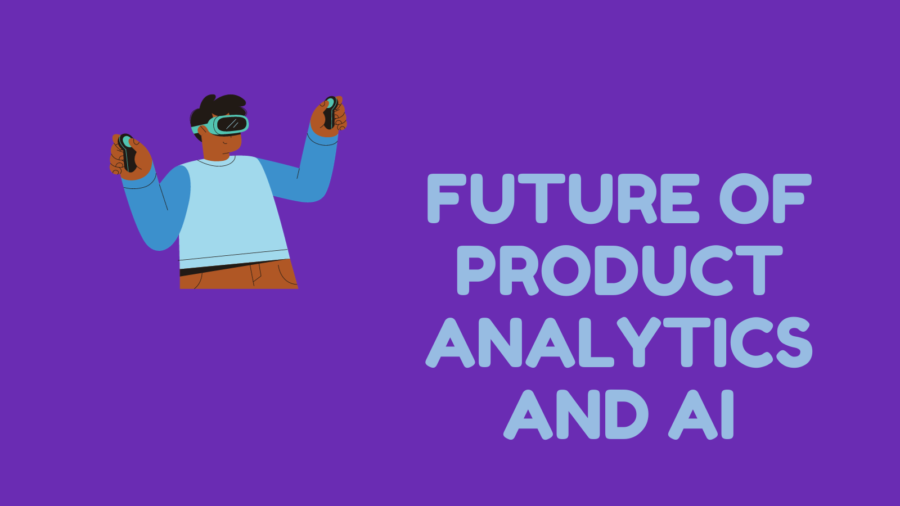The convergence of data analytics and artificial intelligence (AI) is shaping the future of product development, customer engagement, and overall market competitiveness. Product analytics, the practice of gathering and interpreting data related to product usage, user behavior, and customer feedback, has become an indispensable tool for organizations looking to stay ahead in today’s data-driven landscape. When combined with AI, product analytics provides insights and drives innovation, personalization, and efficiency to new heights.
Let’s dive into the exciting realm of the future of product analytics and AI, exploring the trends, challenges, and opportunities that lie ahead.
1. AI-Powered Predictive Analytics: One of the most promising aspects of the future of product analytics is predictive analytics. Organizations can anticipate user behavior, market trends, and product performance by leveraging AI algorithms. This enables companies to make real-time data-driven decisions, whether forecasting demand, optimizing pricing strategies, or identifying potential issues before they escalate.
2. Enhanced User Personalization: AI can supercharge user personalization. As technology evolves, we can expect product analytics to offer more advanced and granular insights into individual user behavior. By understanding each user’s preferences, habits, and needs, companies can create highly personalized experiences, increasing customer satisfaction and loyalty.
3. Automated Insights: AI-driven product analytics will automate the process of extracting meaningful insights from vast datasets. This reduces the burden on data analysts and allows businesses to make quicker, more informed decisions. Automated insights can also uncover hidden patterns and correlations that humans might overlook.
4. Improved Product Development: The future of product analytics and AI will play a pivotal role in product development. Companies can use AI to analyze customer feedback, usage patterns, and market trends to guide the creation of new products and features. This iterative approach to product development ensures that products are innovative and aligned with customer needs and preferences.
5. Real-Time Monitoring and Alerting: AI-powered analytics will enable real-time monitoring of product performance. Automated alerts can be triggered when anomalies or issues are detected, allowing organizations to respond swiftly. This proactive approach can prevent downtime, mitigate risks, and enhance overall product reliability.
6. Advanced Natural Language Processing (NLP): NLP, a subset of AI, transforms how companies analyze textual data such as customer reviews, social media comments, and support tickets. In the future, NLP will become even more sophisticated, enabling organizations to gain deeper insights into customer sentiment and extract actionable information from unstructured data sources.
7. Ethical Considerations: With the increasing reliance on AI in product analytics, ethical considerations will become more critical. Organizations must ensure transparency, fairness, and privacy in their data collection and AI algorithms. Building trust with customers will be paramount.
8. Cross-Channel Integration: The future of product analytics will involve seamlessly integrating data from various channels and touchpoints. AI can unify data from web, mobile, social media, and even physical interactions to provide a holistic view of the customer journey. This 360-degree perspective is invaluable for understanding user behavior and optimizing marketing efforts.
9. AI-Powered A/B Testing: A/B testing is fundamental in product development and marketing. AI will make A/B testing more efficient by automating the process, analyzing results in real-time, and suggesting the best course of action based on data-driven insights.
10. Edge Computing and IoT Integration: As IoT devices continue to proliferate, product analytics will extend beyond software products to encompass physical products and IoT ecosystems. Combined with AI, edge computing will enable real-time analysis and decision-making at the device level, opening new possibilities for product optimization and automation.
Challenges and Considerations
While the future of product analytics and AI holds immense promise, it also comes with its fair share of challenges:
1. Data Privacy and Security: As organizations collect and analyze more data, ensuring the privacy and security of that data becomes paramount. Data breaches and privacy violations can have severe legal and reputation consequences.
2. Data Quality: The accuracy and reliability of data are critical for meaningful analysis. Organizations must invest in data cleansing and quality assurance processes to derive trustworthy insights.
3. Talent Gap: There is a growing demand for data scientists, AI experts, and analysts who can harness the power of AI in product analytics. Closing the talent gap in this field will be essential for many organizations.
4. Ethical AI: Developing AI algorithms that are fair and unbiased remains a significant challenge. Companies must be mindful of potential biases in their data and algorithms and work to mitigate them.
5. Regulatory Compliance: As AI and data analytics become more pervasive, regulatory bodies impose stricter rules and guidelines. Staying compliant with these regulations is a complex task that requires ongoing vigilance.
Conclusion
The future of product analytics and AI promises to be transformative. With the ability to predict customer behavior, personalize experiences, automate insights, and enhance product development, organizations that embrace this convergence will gain a competitive edge. However, they must also navigate the ethical, privacy, and security challenges that come with it.
As we move forward, the key to success lies in striking a balance between harnessing the power of AI and maintaining ethical and responsible data practices. The organizations that can do this effectively will not only survive but thrive in the dynamic and data-driven landscape of the future.


